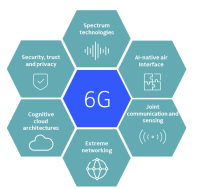Channel Coding for 6G Extreme Connectivity—Requirements, Capabilities, and Fundamental Tradeoffs

Information theory has driven the information and communication technology industry for over 70 years. Great successes have been achieved in both academia and industry. In theory, polar codes and spatially coupled low-density parity-check (LDPC) codes have achieved the theoretical bound. In practice, capacity-approaching coding schemes such as turbo, polar, and LDPC codes are adopted by global wireless standards and implemented with reasonable complexity. However, this by no means suggests a halt in future information theoretic research. For channel coding, coding gain has been the main key performance indicator (KPI). From the practical viewpoint, there is a long list of unfulfilled target KPIs that deserves rigorous and deeper understanding. The inability to fulfil these target KPIs will become the major limitations of future communication systems such as 6G and beyond. Moreover, a diverse set of new 6G services will require new capabilities beyond data transmissions. New opportunities will be created for information theory and channel coding. Above all, we hope that the readers of this survey find the discussion of motivational background and preliminary results from an industry perspective helpful.








